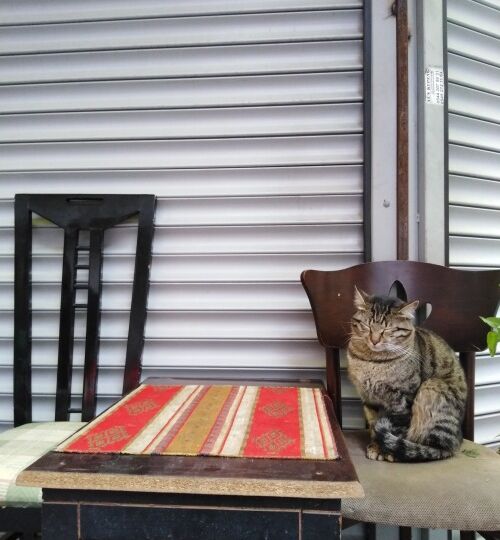
I have been looking forward to writing this post for a very long time, since “[t]hreatened by the normative that cannot offer an alternative to linear history, I never had the luxury of not supporting my own thesis with evidence.”[1] This speculative piece of anti-standard academism for four front paws and at least two voices will actually be a cherry picking of sensorial and intellectual stimuli that washed over me in the last eight months in Istanbul. I will keep the footnotes and references, however, since I always want to say more than what can fit on a regular page.
Plague
While the Great Plague was tightening its grip on London in 1665, and the rich were fleeing the city head on, the city authorities ordered the human population to kill all the domestic animals whose movements could not be easily restrained, since it was thought that pigs, dogs, and cats were spreading the disease. Ultimately, the historians evaluate the number of human victims to be around 100,000, while the number of feline ones goes up to 200,000.[2] We can speculate about the possibility of fewer people dying had they not been ordered to kill the biggest predator of rats, creatures carrying the fleas that the bacteria used to travel around. The human corpses were being identified and counted by plague-searchers—mostly under-privileged women, paid per dead body.
“The female mind is still more subject to these delusions of disordered fancy… Their bosoms are much more susceptible of the injurious influence of seclusion, the contagion of example, and to dangers of illusion.” Thus wrote an eighteenth-century Swiss physician, before presenting the example of a medieval (!) French nunnery, where all the inmates “caught” a mania of meowing individually and collectively for hours on end.[3] This loosely referenced example is still taken as one of the first recorded cases of mass hysteria. The two months of COVID-19 lockdown in ANAMED lead me to doubt Dr. Zimmerman’s conclusions. Namely, none of the four female fellows secluded with me took up my own habit of purring when content and embraced.
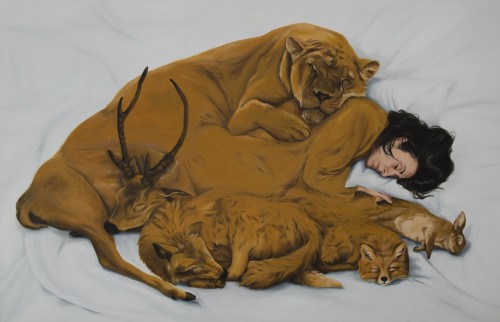
Necla Rüzgar, Innerfauna I (2015)Istanbul Museum of Modern Art
Property
Common sexism aside (or maybe not), I would like to make a sweeping generalization. I believe that the unbridled capitalism and the heritage of private property in the “Western world” found an invaluable accomplice in the Cartesian division between (white, male, Christian, well off) thinking matter and the virtually inanimate extended matter. The definition of animals as moving machines, at the time when machines were meant for making money, paved the way for our non-human companions to become first objects, and then commodities. Is it surprising then that the Hayırsızada dog genocide (1910) was conducted in Istanbul at the time when the Young Turks were desperately trying to morph into “modernity” understood as “Western” capitalism? Starving 80,000 urban dogs to death received the blessing from the Institut Pasteur in Paris. Vagabond dogs still have a harder time than cats assimilating into the human Istanbul.[4]
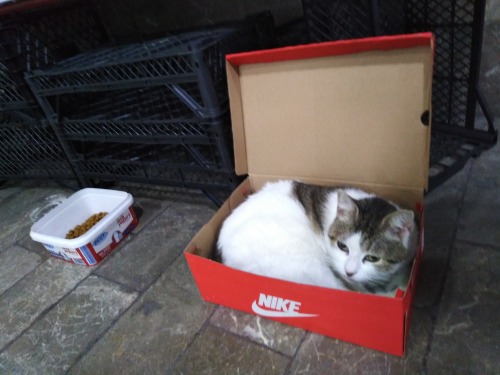
Can animals be commodities? / Spotted in Karaköy. Photo by author.
Despite the fact that the EU Lisbon treaty defines domestic animals as sensory beings, most of the “Western” democracies treat them as property in their legislations. The Turkish Republic, amidst all the visible imperfections of its legal system, strongly opposes that definition. A recent law contends that all domestic animals, be they house-bound, vagabond, or urban, have the right to food, water, shelter, safety, and freedom. Whoever fails to provide them with those things can even end up in prison, depending on the gravity of the offence. Even though animal cruelty is a crime in many Western states, the difference is that in those states you own the animals, while in Turkey you owe subsistence and respect to the animals you don’t own. A laudable legal incentive—arguably barely needed for most Istanbulites at least. Through a dedicated and documented observation of Istanbul’s cats, I’ve come to define their relation to their human co-citizens as one of reciprocal commoning. The ideas of ownership and responsibility seem to fade away next to the ones of community, sustainability, mutuality, and care.
Infrastructure
So, when I would break the weekend COVID-19 curfew in order to fill up old yoghurt containers on my street with cat food, I would find at least some of them already freshly recharged. Still, Burak Taşdizen, a research associate of the Orient-Institute in Istanbul feels that the citizen care for street cats has been affected by the COVID–19 outbreak: “I myself have experienced a street cat running towards me from across the street during one of my walks in Moda, in need of affection if not of water or food. The situation regarding street animals amid COVID-19 has resonated on social media and the Turkish Ministry of Interior has responded very quickly by issuing a letter in order for local administrative bodies to take care of street animals’ needs.”

Cats queuing in a food spot during the COVID–19 pandemic. Spotted in Cihangir Photo by author.
But why do I care what Burak thinks about the urban-cats situation during the pandemic? Because he cared enough to start thinking of them as a topic of his research. More precisely, he is investigating the urban infrastructure that developed around feline Istanbulites (read:cat houses). He told me, in a digital conversation, that he first got this idea while observing citizens’ interventions in public spaces of central residential areas of the city as a part of a PhD-seminar’s[1]walks:“Throughout the interventions that I documented emerged an accumulation of infrastructures built and maintained by the citizens, providing Istanbul’s cats with food, water and shelter. My initial analysis of these infrastructures was based on their temporality and materiality with a focus on their vulnerability in the face of urban currents be they weather conditions or simply neighbors, janitors or passers-by.”
In what, at first sight, might seem to be unaesthetic piles of cardboard boxes and plastic containers abandoned on the side of the road, Burak sees rational “solutions and designerly knowledge productions”: Isolation and insulation of “construction” materials, availability of food and water supplies, clustering of individual units in order to stimulate feline sociability and ensure longer habitation.
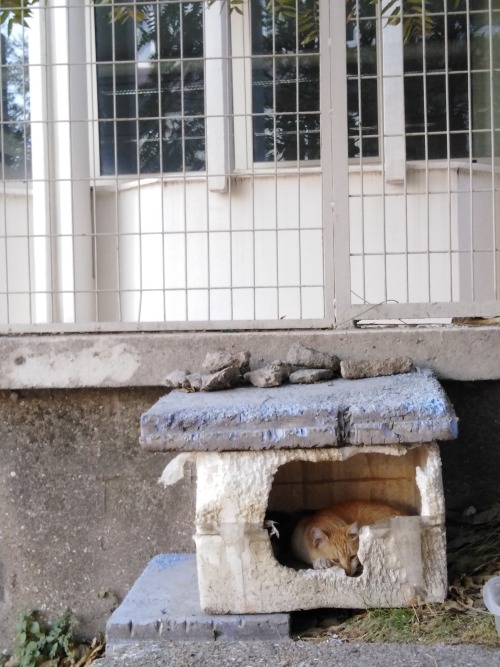
Temporary assemblage. Spotted in Karaköy. Photo by author.
In-between Burak’s remarks confirm some of my hunches about urban cats navigating that narrow, compressed, slippery ground—the commons ground—situated in-between the private and the public, with regards to property, space, and agency. The municipalities like Kadıköy and Şişli claim in their official communication the public space of the street to be the cats’ natural habitat, and the local authorities their primary protectors. But “infrastructures such as those built on windows, or near apartment facades or in apartment backyards challenge the conventional definitions of street cat’s habitat… and the issue gets more convoluted when cats start moving from the street to common areas (ortak alan) such as apartment backyards, where a more one-on-one care can be developed between the care giver citizen and the care receiver street cat.” – says Burak.
Citizen cat infrastructure has a political note to it, too. Its insertion reclaims the right to the city for its non-human and human inhabitants alike. Burak explains that most Istanbul cat houses are set up through citizens’ initiatives, whether they order them from municipalities or commercial facilities, or construct them themselves. He calls them citizen-led temporary assemblages: “I believe the municipalities and muhtarlıklar could learn from the know-how of citizens (citizen-designers, citizen-caregivers) in shaping a more-than-human Istanbul. Already-repeating design decisions point at tried-and-tested solutions of care [that are] being consolidated and enriched for the well-being of this beloved non- human animal population who has the right to care and life as much as (if not more than) us human Istanbulites.”
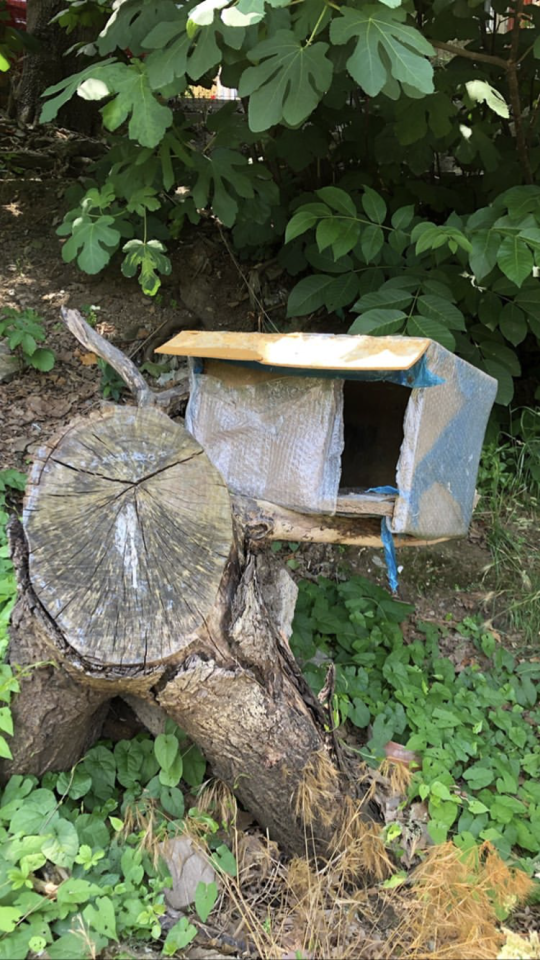
Temporary assemblage – adaptation of a commercial product . Spotted in Moda, Kadiköy. Photo by B. Taşdizen.
Another story / why?
But why do these human citizens spend so much money and go through so much trouble? “I think, wherefore they’re mad!” – Descartes would cry. “Can they at least ride them to work?” – Henry Ford would ponder. During the first month of my stay in ANAMED, Bianca, Güldem, and I went to see Fabrizio Terranova’s Donna Haraway: Story Telling for Earthly Survival at the SALT walk-in cinema. Then I read Staying with the Trouble: Making Kin in the Chthulucene. “It matters what matters we use to think other matters with. It matters what thoughts think thoughts, what stories tell stories” – Harraway relentlessly repeats while telling the story of sympoiesis, a collective and solidary worldbuilding by humans and non-humans. Is it unthinkable to supplant the story of human matter that thinks the non-thinking animal matter, with the story of (at least) two similar matters that co-create the world (and the city) together, just like that?
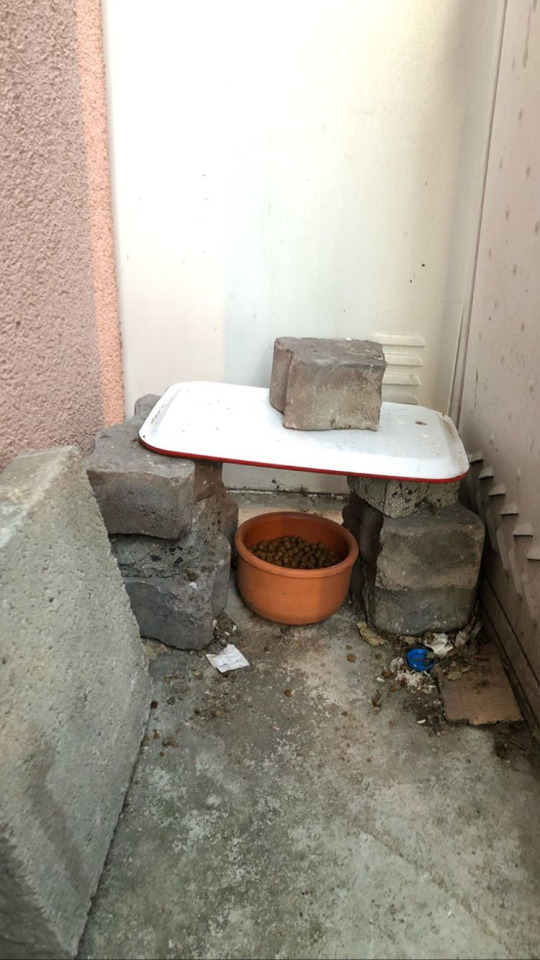
Temporary assemblage – weather-proof food place. Spotted in Kuzguncuk, Üsküdar. Photo by B. Taşdizen.
When I ask him “Why do humans care about the cats here? Because of rats? Because of gods?”, Burak says: “Breeding a cat is considered a sunnah: Prophet Mohammad himself befriended a cat named Muezza as has been told. The positive image of cats in Islam, I believe, has allowed cats to thrive in Istanbul and beyond. Still, recognizing that the human-cat co-evolution might have benefited both parties throughout history on more functional terms, I would refrain from interpreting the current street cat-citizen relationship on a functional ground. I think it has to do with the notion of compassion (merhamet) towards animals than anything else.“ There, it took four sentences to change the story of human and non-human co-existence.
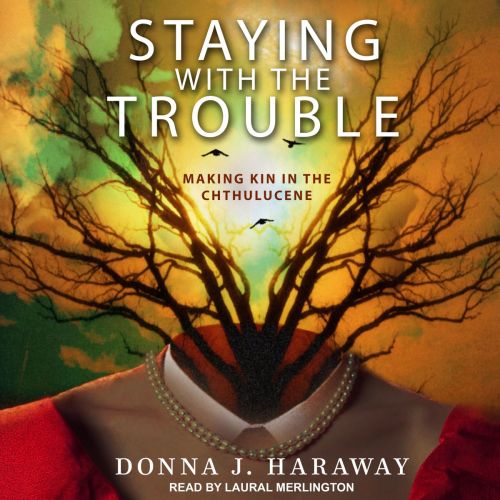
Donna Harraway, Staying with the Trouble, audiobook cover.
Care
I started with Londoners killing cats, thinking they were contagious. I continued with Istanbulites risking fines, arguments, or even contagion in order to feed the cats and give them shelter. I could end with bitter, ironic comments, anthropomorphizing cuteness or violence, or current political contagion blame games. But I choose not to, because this story/history is neither linear nor circular. It’s always fuzzy.
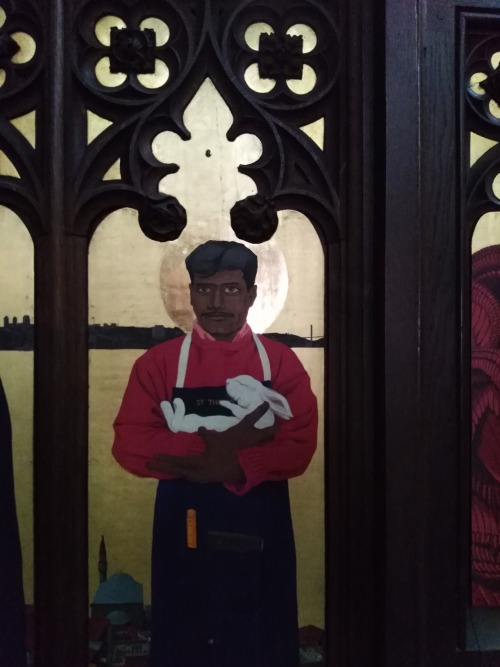
St. Thomas and the rabbit. Spotted in the Crimea memorial church, Beyoğlu. Photo by author.
I want to end with care. So many world leaders used the metaphor of war, and military language in general, to describe the current COVID-19 crisis. The leaders were crying war, while the citizens were taking drastic care of each other. Why does care need a military metaphor to be communicated and taken seriously? Is it hard to imagine it becoming a political concept? Not a soggy abstract common place, but a radical social act? I say care when I mean care. And here, I learned to say cat when I mean care.
Because I spoke with the person whose job is to observe and think about these things, you know, and he said: “In my opinion, Istanbul with its cat houses, provides a fruitful ground to discuss and imagine alternative futures on the cohabitation of domesticated animals and humans in urban environments, reminding us that societies have always been interdependent, and care is vital.” Thank you, Burak. Care is vital.
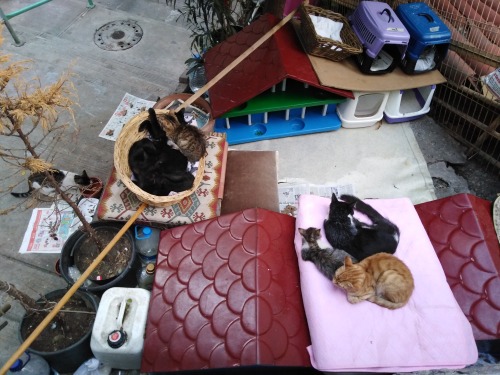
Cat colony in Cihangir. Photo by author.
I want to thank Catie for correcting the text and being entangled in my life here, Burak for the words and the photos, Güldem and Bianca for ideas and feelings, six other lockdown dwarves for making this period livable, and the fat cat from Kallavi Sokak for running towards me at midnight with all his fat flying around him.
—————————————————————————————
[1] T. Serttaş, Foto Galatasaray: Studio Photography of Marian Şahıyan,Istanbul, 2016, 8
[2] L. & D. Moote,The Great Plague: The Story of London’s most Deadly Year, Baltimore, 2004; D. Defoe,History of the Plague in London, New York – Cincinnati – Chicago 1894: “It is incredible, if their account is to be depended upon, what a prodigious number of those creatures were destroyed. I think they talked of forty thousand dogs and five times as many cats; few houses being without a cat, some having several, sometimes five or six in a house.”
[3] J. G. Zimmermann, Solitude, London, 1805, 266.
[4] Chris Pearson, “Stray Dogs in Istanbul,” Sniffing the past: https://sniffingthepast.wordpress.com/2012/05/03/stray-dogs-in-istanbul/.
For another attempt to cleanse the city streets that same year, check out this ANAMED blog post https://anamedblog.com/post/182215613343/whose-streets-are-these-streets.
[5] “Qualitative Approaches in STS: Cyborgs and Technobodies,” Dr. Melike Şahinol, Özyeğin University, Design, Technology and Society.

